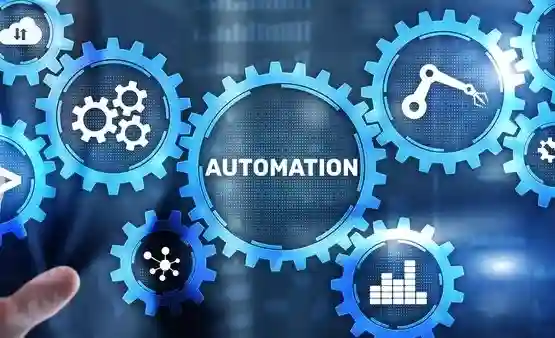لغات مربوط به Automation
در اینجا ۵۰ واژه کاربردی انگلیسی مرتبط با اتوماسیون و معنی فارسی آنها آورده شده است:

برای دانلود پی دی اف و فایل آموزشی مقاله لغات مربوط به Automation کلیک کنید:
1. Automation – اتوماسیون
2. System – سیستم
3. Robot – ربات
4. AI (Artificial Intelligence) – هوش مصنوعی
5. Algorithm – الگوریتم
6. Machine Learning – یادگیری ماشین
7. Software – نرمافزار
8. Hardware – سختافزار
9. Process – فرآیند
10. Efficiency – کارایی
11. Integration – یکپارچگی
12. Control – کنترل
13. Sensor – حسگر
14. Data – داده
15. Output – خروجی
16. Input – ورودی
17. Workflow – جریان کار
18. Task – وظیفه
19. Scalability – مقیاسپذیری
20. Monitoring – پایش
21. Feedback – بازخورد
22. Programming – برنامهنویسی
23. Debugging – خطایابی
24. Configuration – پیکربندی
25. User Interface (UI) – رابط کاربری

26. Quality Assurance – تضمین کیفیت
27. Remote Access – دسترسی از راه دور
28. Telecommuting – دورکاری
29. Deployment – پیادهسازی
30. Upgrade – ارتقاء
31. Maintenance – نگهداری
32. Streamlining – سادهسازی
33. Optimization – بهینهسازی
34. Artificial Neural Network – شبکه عصبی مصنوعی
35. Cloud Computing – رایانش ابری
36. User Experience (UX) – تجربه کاربری
37. Bot – ربات
38. Task Automation – اتوماسیون وظایف
39. Real-time – زمان واقعی
40. Scripting – اسکریپتنویسی
41. Digital Transformation – تحول دیجیتال
42. Smart Technology – فناوری هوشمند
43. Analytics – تجزیه و تحلیل
44. Cybersecurity – امنیت سایبری
45. RPA (Robotic Process Automation) – اتوماسیون فرآیند رباتیک
46. Inventory Management – مدیریت موجودی
47. Artificial Agent – عامل مصنوعی
48. Protocol – پروتکل
49. Interoperability – قابلیت همکاری
50.Process Flow – جریان فرآیند
Understanding Automation in Modern Systems
Automation refers to the technology that allows processes to operate automatically, minimizing human intervention. In today’s world, automation systems integrate various components such as robots, artificial intelligence (AI), and machine learning to enhance efficiency and productivity. The core of any automation system lies in its algorithm and software programming. These algorithms process input data to generate an output that optimizes workflows.
By utilizing sensors, automation systems can monitor environmental conditions in real time, ensuring that tasks are completed accurately and efficiently. One significant aspect of automation is the integration of different technologies.
For instance, cloud computing enables remote access to systems, allowing for telecommuting and improved collaboration among teams. Moreover, the user interface (UI) plays a critical role in the user experience (UX), making it easier for operators to interact with the system.
Task automation can streamline repetitive duties, thereby increasing overall productivity.
This is particularly evident in inventory management, where automated systems can track stock levels and reorder supplies without human input.
Furthermore, robotic process automation (RPA) can significantly reduce the time spent on administrative tasks by mimicking human actions. To ensure the success of automation initiatives, organizations must focus on quality assurance, regular maintenance, and upgrades of both hardware and software.
Additionally, analytics and feedback mechanisms are essential for continuous improvement and optimization of processes. While automation brings numerous benefits, it also presents challenges, such as ensuring cybersecurity and addressing the potential stigma associated with job displacement. Therefore, it is crucial for businesses to engage in advocacy and education to raise awareness about the advantages of automation.
In conclusion, automation is a vital component of digital transformation, enabling organizations to thrive in a competitive landscape. By leveraging smart technologies and maintaining a focus on scalability and interoperability, businesses can navigate the complexities of modern workflows and achieve sustainable growth.


